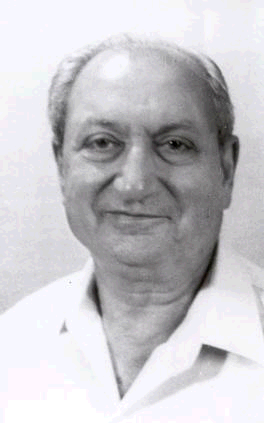 Romesh
Bhandari,
1998
Romesh
Bhandari,
1998by T. Sabaratnam
(Volume 2)
I was with Indian Foreign Secretary Romesh Bhandari in his office in South Block doing an interview for the Daily News on 23 May 1985 when the door opened and a short person peeped in. "Excuse me for two minutes," Bhandari told me as he walked to the door. I saw them holding hands and Bhandari saying, "I will meet you in Colombo."
 Romesh
Bhandari,
1998
Romesh
Bhandari,
1998
When he returned to the sofa where we were seated, Bhandari volunteered, "He is our new High Commissioner. He is going to Colombo to be there when I go to Colombo."
"Why didn’t you introduce him to me? I am the one who will be covering him there," I said.
"You can meet him in Colombo."
I did meet J. N. Dixit, the new Indian envoy, in Colombo on 27 May. He had reached Colombo the previous afternoon and presented his Letter of Credence to Foreign Minister A. C. S. Hammed the same night. He presented his credentials to President Jayewardene at 9:30 am on 27 May and I was the first Sri Lankan journalist to interview him.
I had flown back to Colombo that morning after breaking journey at Chennai and rushing to Trichy to spend a day with my brother and his family.
At Trichy, I tried to meet one of my Indian friends who had served earlier at the Indian High Commission in Colombo. I was told that my friend was in Chennai goading Tamil groups to fall in line with India’s new Sri Lanka policy. In June, he accompanied Tamil representatives to Delhi.
India’s new policy towards Sri Lanka was the topic I was probing with Bhandari when Dixit came to say farewell to him. Bhandari told me Rajiv Gandhi was interested in creating a zone of peace in South Asia. Rajeev wanted to build friendly relations with India’s neighbours. He wanted to get rid of the image that India was quarrelling with its neighbours. He wanted to get rid of the accusation that India is acting like a big brother.
Bhandari told me that India’s relationship with Sri Lanka would be fashioned within that general framework. "In Sri Lanka fighting should cease and political negotiations begin. I would do the groundwork for that when I go to Sri Lanka on the 28th," he said.
I knew that the necessary groundwork had been done since his first visit in March and thus asked him whether Tamil groups were toeing that line. His reply was, "They will have to," and added, "They can obtain what they want through negotiations."
Naturally, I did not ask the next question that came to my mind: 'Will Jayewardene play the game according to your rules?'
Daily News led with that story and, when I returned, my editor Manik de Silva told me that Lalith Athulathmudali had asked him to thank me. De Silva also asked me to interview Dixit at India House. Dixit looked surprised when he saw me. "Were you the person who was with our Secretary when I called on him before I left for Colombo," he asked. That and the fact that I studied at Madras Christian College brought us close.
Dixit told me that Hameed was very courteous and had told Dixit that he had arrived in Colombo at a critical period in Sri Lanka’s political evolution and Indo- Lankan relations. Hameed had also told him that Sri Lanka expected the new Prime Minister to be more objective and positive than his mother. It was on that expectation that President Jayewardene had agreed to the Indian proposals that Sri Lankan representatives should talk to the leaders of Sri Lankan Tamil armed groups.
At that very first meeting, I found that Dixit was extremely friendly with journalists and was an expert in handling them; telling them what they wanted and making use of them for his own purposes. He told me the details of the conversation that followed his formal presentation of the credentials to President Jayewardene with the caution, "Please don’t quote me." Dixit said he had informed the President that Bhandari would arrive at 4pm by a special plane the next day (28 May) to discuss the details of the meeting between the Sri Lanka government and Tamil delegations. Dixit had also told him that Bhandari would inform the President of the composition of the Tamil delegations. Bhandari would also invite President Jayewardene to visit Delhi for discussions with Rajiv Gandhi.
Dixit said Jayewardene told him he looked forward to his discussions with Rajiv Gandhi and expressed the hope that he would remove past tensions and mutual prejudices.
The groundwork for the meeting between the Sri Lankan and the Tamil delegations had been made by RAW chief Saxena, He had also handed him a copy of the secret document that gave the conditions and timetable for ceasefire and peace talks prepared after his discussions with Lalith Athulathmudali.
 Girish
Chandra
'Gary'
Saxena
Girish
Chandra
'Gary'
Saxena
Dixit told me that his mission would be to make the Indian proposals for a ceasefire and talks a success. He made use of my interview to prepare the Sri Lankan public for a ceasefire and for talks between the government and the Tamil armed groups.
Tamils Upset
Leaders of the Tamil liberation movements, especially Pirapaharan, were disturbed with India’s new policy. The United Front of ENLF and LTTE met frequently to plan their strategy to deal with this development. And Jayewardene and Athulathmudali were also busy mapping out their strategy to make use of India’s new policy to gain time to build up the armed forces and destroy the Tamil armed struggle and the basis of the Tamil demand for regional autonomy.
Jayewardene needed a pause in armed attacks because the armed forces were under severe strain and were gradually becoming holed up in their camps and stations. In the Jaffna peninsula the police had abandoned its law enforcement duties and were engaged it protecting the police stations. In the rest of the northern and eastern provinces, the police and the army went about in convoys of armoured vehicles.
The armed groups escalated their attacks on police and army convoys and on the police stations and army camps.
The Jaffna police station attack of 10 April, the day the LTTE joined hands with the ENLF, sent a shock wave to the armed forces and the government. Jayewardene’s reaction of intimidation and revenge, by unleashing a series of brutal attacks on Tamil civilians, worsened the situation. It won for the armed groups popular support and fresh recruits. And it helped Pirapaharan to strengthen the role of protector of the people which he had begun to play since the beginning of 1984. The LTTE and other groups perfected the strategy, combining landmine attacks and attacks on police stations with the role of protecting the civilian. They blocked the police and the army from moving out of their stations and camps by mining the roads and setting up ambushes.
An LTTE group led by Mahattaya blew up a jeep that went on a convoy at Oddusuddan in the Mullaitivu district on 21 April, 1985 in retaliation for the shooting of 27 civilians who were crossing over by boat from Tamil Nadu to Jaffna four days earlier, defying the government ban on sea travel. Lalith Athulathmudali justified the shooting by saying that all those who defied the travel ban were presumed terrorists. Mahattaya's landmine explosion killed four soldiers.
The army retaliated. It conducted a cordon and search operation in the area the landmine was exploded. It took away 24 Tamil youths and shot them. The army claimed that they were all members of the LTTE who died during the firefight that followed the landmine explosion. The army also killed ten Tamils travelling in a van. It claimed that it had shot and killed ten terrorists.
Mahattaya and his men ambushed an army convoy of eight armoured vehicles and a jeep at 2 pm the next day (22 April) in Puthukudiyiruppu in Mullaitivu killing 20 soldiers.
And on 25 April, PLOTE, in a rare military operation, attacked a remote police station in Madawachchiya, a Sinhala area, and carried off 12 rifles, 24 shot guns, a sub-machine gun and ammunition. A Sinhala policeman died in the attack and PLOTE, which was talking of a national revolution, apologized for killing a Sinhalese.
On the same day EROS attacked a unit of the elite Special Task Force (STF) in the Ampara district killing six men.
The next day, 26 April, the LTTE’s Trincomalee leader Santhosam Master and Pulenthiran Amman attacked an army convoy at Kaddaiparichchan in the Trincomalee district. The landmine blew up the lead jeep killing a lieutenant and six soldiers.
This was followed up two days later (28 April) by two landmine attacks on the army in the Jaffna district. Of those, the first attacked added a new dimension and Kittu, who led the attack, told the Jaffna daily Eelanadu that he had planned it according to Pirapaharan’s instruction. The landmines were buried on the road near Navindil Veethi in Karaveddi. "We planned to blow up the lead jeep. We expected the soldiers in the personnel carriers that followed the jeep to jump out, take up positions and open fire. We placed an attack group behind the position the soldiers would take. It was instructed to open fire at the soldiers once they open fire. Everything happened as we planned," Kittu said.
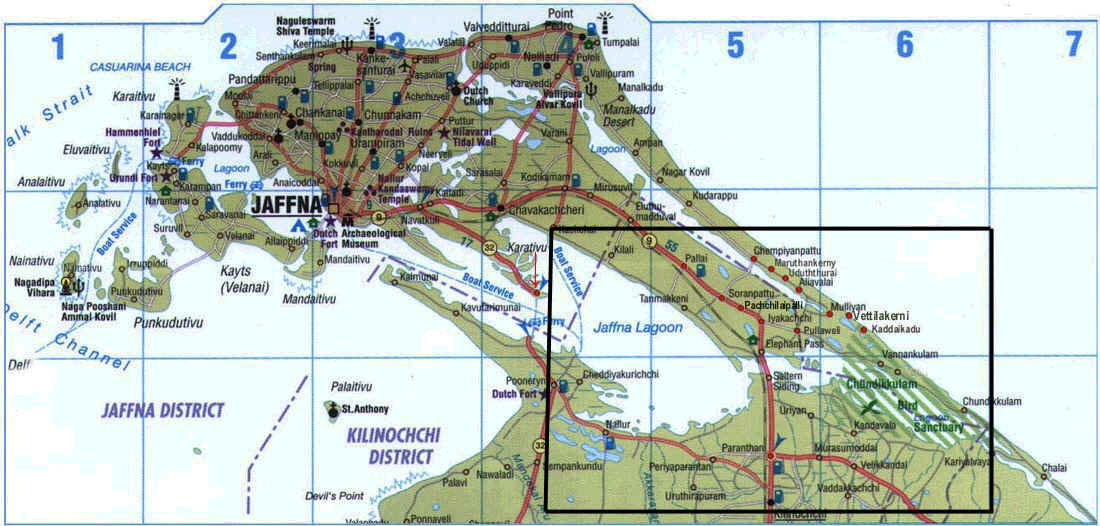
The lead jeep of the eight-vehicle convoy was blown up by the landmine. Eight soldiers died. The soldiers from the armoured vehicles jumped out, took up positions in the adjoining fields and opened fire. The attack party fired at the soldiers from behind killing ten soldiers. The army lost 18 soldiers in that attack. The Tigers suffered no loss.
On the same evening the Tigers lay in hiding close to the Point Pedro police station waiting for the soldiers to come out of their camp nearby. They threw grenades and patrol bombs at a jeep that came out. Four soldiers died.
Two days later, on 30 April, LTTE fighters fought a direct gun battle with the army with soldiers who had proceeded from Gurunagar to Colombuthurai and turned towards Ariyalai along the Nedunkulam road. The soldiers withdrew after losing ten of their men.
Refugee Problem
Attacks on civilians were the only answer the army had. And it forced more Tamils to flee to India. The attacks on the civilians and the consequent refugee problem inflamed feelings in Tamil Nadu. Both matters were raised on 3 May in the Indian Parliament, both in the lower house, the Lok Sabha and upper house, the Rajya Sabha. The Prime Minister replied in the Lok Sabha.
Rajeev said, "Our concern is for the Tamils in Sri Lanka. The concern is not only of people in the South, but it is the concern of everyone in India. We have to see that the refugees go back, go back in honour, go back safely, go back with security of expecting and getting full freedom to express themselves, to work, to live within the integrity of Sri Lanka. We have made our position clear many times on this."
Deputy Foreign Minister Khurshid Alam Khan replied in the Rajya Sabha. He used stronger words. He said that the happenings in Sri Lanka were "deplorable, brutal, barbaric, cruel and inhuman" and urged Colombo to replace the army in Tamil areas with an "ordinary police force."
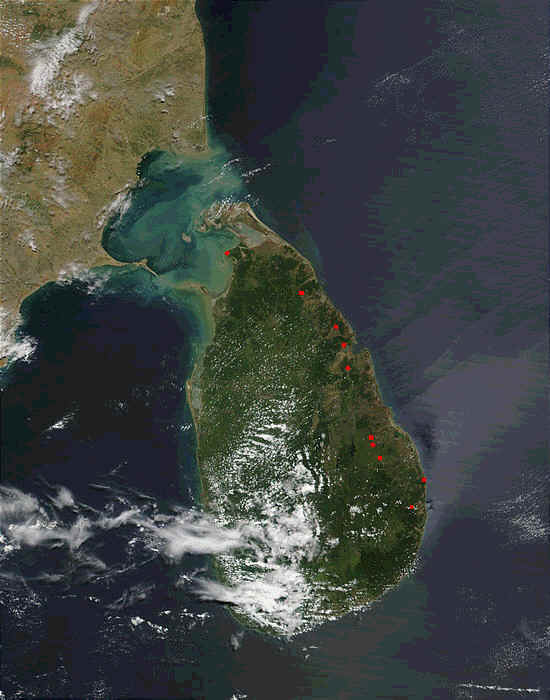 An
annoyed
Jayewardene
signaled
the
state
media
to
commence
a
propaganda
onslaught
against
Alam
Khan.
Jayewardene
told
the
heads
of
the
state
media,
Rupavahini,
SLBC
and
Lake
House,
not
to
attack
Rajiv
Gandhi.
He
wanted
to
cultivate
the
friendship
of
Rajiv
Gandhi,
whom
Sri
Kotha
circles
called
‘a
novice,’
but
to
attack
the
South
Block
which
Colombo
perceived
as
continuing
the
pro-Tamil
policy
originated
by
Parthasarathi.
The
UNP
planning
body
activated
its
network.
A
propaganda
onslaught
against
India
was
unleashed.
An
annoyed
Jayewardene
signaled
the
state
media
to
commence
a
propaganda
onslaught
against
Alam
Khan.
Jayewardene
told
the
heads
of
the
state
media,
Rupavahini,
SLBC
and
Lake
House,
not
to
attack
Rajiv
Gandhi.
He
wanted
to
cultivate
the
friendship
of
Rajiv
Gandhi,
whom
Sri
Kotha
circles
called
‘a
novice,’
but
to
attack
the
South
Block
which
Colombo
perceived
as
continuing
the
pro-Tamil
policy
originated
by
Parthasarathi.
The
UNP
planning
body
activated
its
network.
A
propaganda
onslaught
against
India
was
unleashed.
Army attacks on civilians and the anti-India propaganda onslaught resulted in the stepping up of attacks by the armed groups and the Anuradhapura massacre.
On 4 May, EPRLF attacked the Kayts Naval base and the Gurunagar camp. The naval base attack ended in failure. Sinnavan, EPRLF’s Trincomalee commander, who manufactured the mortar launcher, took charge of the mortar attack. He fired mortars into the camp and they exploded inside the camp causing havoc and terror. Naval personnel withdrew to the rear of the camp.
EPRLF’s attack group rushed to the camp’s entrance in a locally-manufactured armoured vehicle. Then the unexpected happened. A mortar that Sinnavan fed the launcher exploded inside the barrel, blowing him to pieces. Naval personnel advanced to the entrance firing. They shot dead 22 EPRLF fighters, forcing them to call off their attack. Velu and Ganesh, both top men, also died. It was a big blow to the EPRLF. The Gurunagar attack was a minor assault to divert the attention of the army.
Three days later, on May 7, the LTTE attacked the Valvettithurai Camp and killed five soldiers. Two days later, on 9 May, another land mine attack by the LTTE killed an army major and five others.
The army reacted violently. It cordoned off the coastal villages, searched every house in that area and took away all young men. Their hands were tied behind their back. They also shot some of them dead. Twelve were lined up near a bathing well and shot. Some were shot inside their homes. The most cruel killing took place at Oorani, a village east of Valvettithurai, where 25 young men were herded into a room in the community centre and blown up. The army killed a total of about 75 young men.
This angered Pirapaharan and the entire Tamil community in Sri Lanka, and Tamil Nadu and India were incensed. India reasoned that Jayewardene was pursuing a military path and needed to be tamed and brought back to the political course.
While his troops was killing Tamils, Jayewardene continued his Machiavellian strategy of weakening New Delhi by continuing his efforts to win over Rajiv Gandhi. He made use of the occasion of the Centenary celebrations of the Indian National Congress, of which Rajiv Gandhi was the president, for his purpose. Jayawardene wrote Gandhi a letter on 7 May. It read,
Mr. President,
On the occasion of the Celebration of the Centenary of the Congress Party of India, I take great pleasure in extending to you and to all members of the Congress Party my sincere greetings and good wishes.
I attended, as a youth, Ramgath Sessions of the Congress in the State of Bihar in 1940. It was the last sessions of the Congress held before India achieved her freedom. We came as a delegation from the Ceylon National Congress, which we were attempting to revive, reorganize and revitalize, on the lines of the Indian Congress. At that time, Sir Moulana Azad, the president of the Congress for that year, Mahatma Gandhi and Pandit Nehru inspired us in our efforts to study some of the experiences of the Indian Congress Party. Two years later, I again attended the Executive Committee meeting of the Indian National Congress held in Bombay in August 1942. Here Mahatma Gandhi supported the ‘Quit India Resolution’ when the Indian Congress under his leadership decided to organize a movement which would not be abandoned until the freedom was attained. That movement inspired us to adopt Mahatma Gandhi’s methods to regain our own freedom.
Your great leader Mahatma Gandhi followed the teachings of the Lord Buddha based on ‘ahimsa’, non violence, which has illumined our lives in Sri Lanka, a neighbour of your great nation, we have always admired those qualities of moral leadership which helped to build your country. It is, fitting, therefore, that I should be sending a Message to the grandson of Pandit Nehru. Under your leadership, I am sure that those ideals held by the Indian National Congress will be further strengthened and revitalized for the future good of all of us in and around India.Signed
J. R. Jayewardene.
President.
Socialist Republic of Sri Lanka
This letter failed to have the effect his letter of 1 March had on Rajiv Gandhi. Army attacks on civilians, the influx of refugees and the resistance Jayewardene and Athulathmudali showed during the secret discussions RAW and Indian High Commission had with them about the formulation of the agenda and time table for talks had blunted Rajiv Gandhi’s admiration for Jayewardene.
RAW stepped up its effects to pressurize Jayewardene to abandon the military path he was trotting and adopt the path of political negotiations. On RAW’s prodding TELO raided the TV relay tower and the army camp at Kokilai on 10 May and the Tigers, four days later, mowed down 148 civilians including several worshippers in the holy town of Anuradhapura.
In the Kokilai raid TELO killed a dozen soldiers, but lost nine of their men. TELO’s loss was due to the heavy weapons the soldiers used. The armed groups realized that the weapons India supplied would not help them to take forward the freedom struggle. The LTTE was the only exception. Pirapaharan knew from the start that India would control their military operation through the weapons they supplied. He had equipped his fighters with weapons superior to the American and British weapons the army was procuring.
In the next two days the LTTE staged three daring attacks in three areas. On May 11, the LTTE under the command of Victor, attacked and destroyed the Mannar police station. It killed several policemen and removed a large haul of weapons, including sub-machine guns and automatic weapons. On 12 May, the LTTE led by Santhosam fired at a police jeep near Trincomalee town and killed four policemen. It ambushed the police party that rushed to help the victims and killed another ten police commandos. On the same day, the LTTE killed 13 soldiers in a landmine explosion in the Jaffna district.
India Today captured the state that prevailed in the northeast in these two sentences:
Sri Lanka was shaking like an aspen leaf… They (armed groups) were harassing the Sri Lankan forces almost throughout the length and breadth of the sprawling northeast, as if they were implementing a well-drawn plan to make Colombo kneel.
Anuradhapura Attack
The Anuradhapura attack did that. In the morning of 14 May, a Poya Day (Full Moon day), 14 LTTE fighters led by Victor, dressed in army uniform, hijacked a bus plying the Puttalam-Anuradhapura road. They drove in it to the central bus station in the centre of the ancient Anuradhapura city, the capital of the Sinhala kingdom from 5th Century B.C. to 10th Century A.D. They sprayed automatic fire killing about 100 passengers waiting there, men, women and children.
Then they proceeded to the sacred Bo Tree venerated by the Buddhists worldwide. It was venerated because it was the sapling of the Bo Tree under which Gautama Buddha, the founder of Buddhism, attained Enlightenment. It was brought and planted in Sri Lanka by the Indian emperor Asoka’s daughter, Sangamitta, in the 3rd Century B.C. The Tiger fighters again mowed down Sinhala Buddhist pilgrims, including Buddhist monks, nuns and white-clad worshippers.
The attackers drove back to Wilpattu, firing at a police station on the way. They also killed forest guards at the wild life sanctuary. The total killed was 148 persons.
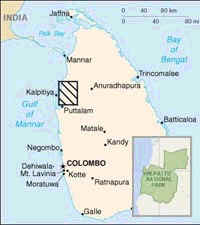 By
the
time
police
declared
curfew
and
rushed
commandos,
the
attackers
had
gone.
A
helicopter
sent
from
Anuradhapura
Air
Force
grounds
to
track
the
fleeing
attackers
spotted
the
bus
as
it
entered
the
Wilpattu
forest.
It
opened
fire.
The
attackers
abandoned
the
bus,
took
cover
and
fired
back.
The
gunner,
Jaffna-born
Sergeant
Hatha
Kapuralage
Dayaratne,
was
hit
in
the
leg,
hand
and
the
chest.
The
helicopter
flew
away.
Dayaratne,
now
50,
is
still
living.
He
lost
his
right
hand
and
leg.
He
was
in
the
first
batch
sent
to
Israel
in
November
1985
at
the
instance
of
Ravi
Jayewardene
to
be
fitted
with
artificial
limbs.
By
the
time
police
declared
curfew
and
rushed
commandos,
the
attackers
had
gone.
A
helicopter
sent
from
Anuradhapura
Air
Force
grounds
to
track
the
fleeing
attackers
spotted
the
bus
as
it
entered
the
Wilpattu
forest.
It
opened
fire.
The
attackers
abandoned
the
bus,
took
cover
and
fired
back.
The
gunner,
Jaffna-born
Sergeant
Hatha
Kapuralage
Dayaratne,
was
hit
in
the
leg,
hand
and
the
chest.
The
helicopter
flew
away.
Dayaratne,
now
50,
is
still
living.
He
lost
his
right
hand
and
leg.
He
was
in
the
first
batch
sent
to
Israel
in
November
1985
at
the
instance
of
Ravi
Jayewardene
to
be
fitted
with
artificial
limbs.
I was in Lake House when the news about the Anuradhapura massacre reached Colombo. Sinhala Buddhists reacted with anger. Tamils feared more riots, but it did not happen. Tamils realized that, in the absence of instigation by the government, people by themselves would not resort to violence. I rushed to Torrington Square Flats, to which we had moved after the 1983 riots, to protect my son who was with me. As I reached that place, a police patrol came around. I told my son, "Don’t worry. In future, there won’t be riots. The government will not instigate it." That proved correct. For the last 21 years there has been no riot.
The Sinhalese media kept congratulating the Sinhala people for keeping peace. They said the Sinhala people had matured. Tamils knew that that was not the correct assessment. The Sinhala people did not attack the Tamils because Jayewardene's government did not instigate them. Jayewardene government did not instigate the rowdy elements in the Sinhala people because he knew the armed groups would retaliate.
As usual, the Sinhala media missed the point. It did not realize the greatness of the Sinhala people. Thondaman pointed it out in a statement. He said what happened in July 1983 was not a Sinhala revenge or retaliation. It was a terror well-organized by Jayewardene. Pirapaharan also pointed it out in his interview to Anita Prathap.
Jayewardene was stunned by the Anuradhapura attack. Athulathmudali was shocked. Both knew that the massacre would erode their credibility among the Sinhalese people. They suspected RAW’s hand behind the escalation of violence in the northeast and the Anuradhapura massacre. That suspicion was openly voiced by the media.
Kumuthini Killing
The Jayewardene-Athulathmudali combine decided on a dual course of action: take steps to regain the confidence of the Sinhala people and lull India through continuing talks for a political solution. The first course of action resulted in a series of savage civilian massacres. The second led to the agreement to talk to the armed groups.
The first of this series of massacres occurred on 15 May, the day after the Anuradhapura massacre. Around 7.40 am that day the ferry named Kumuthini started its daily journey from the island of Delft to Kurikadduvan, the pier from where buses ply to Jaffna. About 80 passengers, including women and children, travelled in that motorized ferry.
Kankesu Santhalingam, his wife Kusalakumari, sister-in-law Anushya, their aunt Saroja and her child Legi was one of the families that travelled that morning. Kanapathipillai Ganeshapillai and his family was another. Santhalingam and Ganeshapillai survived the attack to tell the gruesome tale.
In an exclusive interview to the Sunday Virakesari of 25 May 2000, sixteen years after the massacre, they pieced together Sri Lanka’s worst mid-sea butchery. "Half an hour after our departure, when the ferry was travelling between Delft and Nainathievu (Nagadeepa) a fiber boat came towards the ferry. When it neared the ferry, the persons in the fiber boat ordered the boatmen to switch off the engine. Then the fiber boat circled the ferry twice and linked with it. The ferry was at that time near Nainathievu," said Santhalingam.
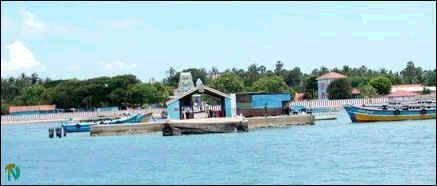 Nainathivu
jetty
Nainathivu
jetty
He continued, "Seven or eight sturdy men dressed in black T-shirts and blue shorts and carrying rifles and other weapons jumped onto the ferry. They were from the navy. I have seen them earlier in navy uniform. One of them walked into engine room and took control of it.
"They ordered the boatmen and the passengers to go on deck. All obeyed. They were then told to get into the room in the forepart. They ordered all men to stand in a line. They asked them whether they had the National Identity Card with them. They said they had. Then the men were asked to go through the engine room to the aft section of the ferry. Others were ordered to shout their names in unison as each man entered the engine room. We heard a gunshot as each passenger entered the engine room. We also noticed bodies falling into the sea.
"I was in the middle of the line. My turn came. When I entered the engine room I saw some bodies fallen in a pool of blood. I was shocked. I screamed. Someone hit me on the head with a pole. I fell over the bodies. They pulled me and cut me with an axe. I pretended to be dead. They left me and attacked the next person. His body fell over me. Then, one by one, the bodies of others piled over me. I t continued for about one and a half hours. Then someone shouted that the navy men had gone and asked those alive to come out. I pulled myself out and got up.
"My wife’s aunt told me that they had killed my wife and her sister. We found that the ferry was drifting towards Delft. We held up a red travelling bag which attracted a fishing boat. It brought another bigger boat. We were taken to Kurikadduwan and then to the Jaffna Hospital," Santhalingam said.
Ganeshapillai adds, "When my turn came I entered the engine room. As I entered, someone hit me with a pole on my head. Another hit me with an axe. I fell down shouting. Another man cut my mouth. I rolled over to a side.
"When I got up after they left, I found a pile of bodies. There were some like me who were alive. We held up a red bag and attracted a fishing boat. The attackers spoke to us in Tamil with Sinhala accent. They spoke among them in Sinhala. I have seen two of the attackers at Nainathievu navy camp. I have seen them in uniform as well as in civilian dress. They used to wear black T-shirts. People there said that they were trained in Pakistan and were dangerous people. I can identify them," he said.
Forty-eight Tamil men, women and children were killed as revenge for the Anuradhapura massacre. It was well-planned butchery. The passengers were killed one by one. The rest were ordered to shout their names to drown the screams of the attacked.
A cold-blooded murder
Amnesty International raised the matter. It provided eye-witness accounts from survivors identifying some of the killers as navy personnel from the Nainathievu Naval Camp. National Security Minister Lalith Athulathmudali denied the charge, "There is no evidence to show who was responsible," was his answer.
The government was forced to order an investigation due to international criticism. The cosmetics of deception were followed. A committee of inquiry was appointed, the inquiry was held and a report submitted. The report was put in the shelf and securely locked. Nothing came of it.
The Natpattimunai massacre that took place two days later was more gruesome.
Next
Chapter 33: Frog Marched to Thimpu (continued)
To be posted February 4